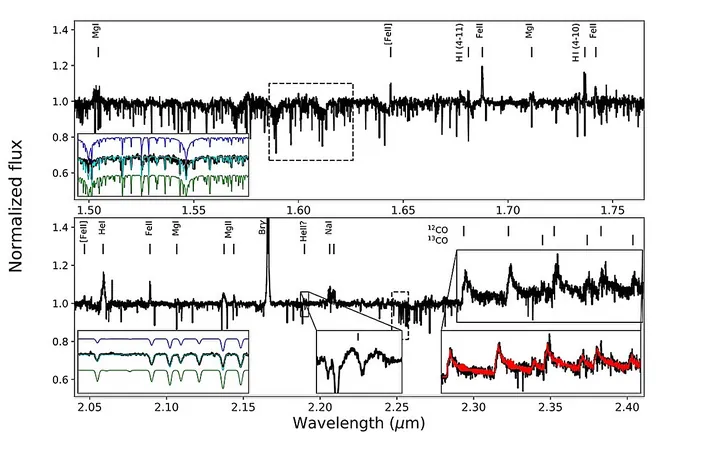
Astronomers Discover RARE Post-Red Supergiant Star HD 144812 in Binary System: What Does This Mean for Stellar Evolution?
2025-04-03
Author: Arjun
Groundbreaking Discovery of HD 144812
In a groundbreaking study, astronomers from the Czech Republic and Argentina have made an astonishing discovery regarding the yellow supergiant star, HD 144812. Utilizing the advanced capabilities of the Gemini South telescope, the researchers have identified HD 144812 as a rare post-red supergiant star surrounded by a companion star—a significant find that offers fresh perspectives on massive star evolution. The results of this research were detailed in a paper published on March 25 on the arXiv preprint server.
Characteristics of Yellow Supergiants
Yellow supergiants (YSGs), which are characterized by their spectral types of F or G and initial masses ranging from 10 to 40 solar masses, represent a fleeting phase in stellar life cycles. Typically, these stars undergo rapid cooling and expansion, transitioning to red supergiants (RSGs) after leaving the main sequence. Fascinatingly, their stay in this phase lasts only a few thousand years, making sightings of them an extraordinary event in astrophysics.
Observations and Findings
The researchers observed that increased circumstellar wind activity can lead to stars changing their trajectory off the RSG branch in the Hertzsprung-Russell diagram. This shift, part of a stage referred to as post-RSG evolution, might be associated with significant mass-loss events akin to those manifested in Luminous Blue Variables (LBVs) and other massive stars.
Under the guidance of Michalis Kourniotis from the Czech Academy of Sciences, a team of astronomers has been conducting spectroscopic observations of YSGs exhibiting infrared excess to expand the catalog of known post-RSG stars within the Milky Way and neighboring galaxies.
The Role of HD 144812 in Stellar Evolution
HD 144812, which lies approximately 2,500 light-years away and was initially classified as a Galactic emission-line YSG in 1978, became a focal point for their studies. This star is notable for its infrared excess—a typical sign of evolved stars that exhibit heightened mass-loss activity.
High-Resolution Spectra and Companion Star
Using the GRating INfrared Spectrometer (IGRINS) at the Gemini South telescope, Kourniotis' team captured high-resolution spectra of HD 144812. Their findings revealed an impressive array of photospheric absorption lines accompanied by distinct emission features, predominantly from hydrogen series and iron. Notably, the most prominent characteristic in the K-band spectrum was the emission from the carbon monoxide molecule's first-overtone bands.
The researchers concluded that HD 144812 is accompanied by a disk-hosting companion, likely made up of materials that have been transported from the star's core to its surface during its earlier red supergiant phase. The data also suggested that HD 144812 is currently transitioning through a post-RSG phase characterized by blueward evolution, with ejected gases from the surface enveloping the star in a disc-like formation.
Implications of the Discovery
The implications of this discovery are profound. As noted by the authors, HD 144812 enriches the limited sample of identified post-RSG stars within binary systems, providing scientists with crucial insights into the final evolutionary stages of massive stars.
Future Research Directions
As a next step, the research team plans to monitor HD 144812 through both infrared and optical wavelengths to gain deeper insights into the dynamics and characteristics of this rare stellar system. With each observation, astronomers hope to unlock the enigmatic life stories of these colossal stars, ultimately piecing together the complex narrative of stellar evolution and the fate of our universe. Stay tuned for more astronomical revelations that could change our understanding of the cosmos!

 Brasil (PT)
Brasil (PT)
 Canada (EN)
Canada (EN)
 Chile (ES)
Chile (ES)
 Česko (CS)
Česko (CS)
 대한민국 (KO)
대한민국 (KO)
 España (ES)
España (ES)
 France (FR)
France (FR)
 Hong Kong (EN)
Hong Kong (EN)
 Italia (IT)
Italia (IT)
 日本 (JA)
日本 (JA)
 Magyarország (HU)
Magyarország (HU)
 Norge (NO)
Norge (NO)
 Polska (PL)
Polska (PL)
 Schweiz (DE)
Schweiz (DE)
 Singapore (EN)
Singapore (EN)
 Sverige (SV)
Sverige (SV)
 Suomi (FI)
Suomi (FI)
 Türkiye (TR)
Türkiye (TR)
 الإمارات العربية المتحدة (AR)
الإمارات العربية المتحدة (AR)